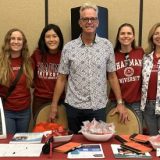Studying the Science of Running
April 28, 2015
The 11th annual Orange County Marathon is upon us, an event attracting participants from all over the nation. As they make their way from Fashion Island to the Fairgrounds, tens of thousands of runners will be on a quest to fulfill a personal dream. Do all these people really consider themselves runners? Sure, the elite class does, but there is always a contingent of first-time and pedestrian marathon runners who never thought they would one day find themselves at the starting line.
Researchers at Chapman University’s Crean College of Health and Behavioral Sciences examine the premise that anyone – when properly trained – can run a marathon, and theorize that humans may actually be built for long-distance running, an idea that’s consistent with some of the evolutionary changes that make us human.
In Chapman’s department of Kinesiology Human Performance Laboratory, Drs. Franks Frisch, Ph.D. and Eric Sternlicht, Ph.D., measure many of the more important attributes to long-distance running. Key to their research is understanding how muscles are recruited. According to Frisch, the brain organizes which muscles are going to move at which time. With practice, one runs more efficiently because the recruitment pattern—as generated by the motor cortex of the brain—tells which muscles to contract so the movement is as smooth as possible. All humans have this capacity, Frisch says, no matter your age, size or physical condition.
“When [kinesiology student] Courtney has the EMG electrodes on, the recordings tells us the timing and pattern the brain is firing signals to the muscles and in the lab we can evaluate the data,” Dr. Frisch said. “We are measuring the muscle’s activity as regulated by the brain’s signals and the muscles ability to respond to the signals. Which muscles are firing and when they are firing is a consequence of your brain’s organization. And that is part of the training. When you’re running you’re also training your brain, in a sense, to be more effective and more efficient in your running.”
Students in the human performance lab also evaluates oxygen utilization, an important component to metabolic rate and energy production, because they’re proportional to the work the body is doing. They measure oxygen, CO2 and nitrogen levels. They also measure the heart rate of athletes to determine the efficiency at which they’re performing, as well as measure the levels or values of chemicals in the blood of individuals to see what changes are being brought about—how much lactic acid is being generated and how much is being taken up by the liver. All humans utilize oxygen. We all undergo metabolism. We all have muscle. A marathon runner and a pedestrian runner, and even a non-runner, all share these basic functions. It’s how trained (modified) they are, along with the starting levels (as determined by genetics) that determined how well we perform in the marathon.
The difference, Sternlicht explained, is in the genetic make-up, degree of training and skill level of runners. “While we can measure metabolic activities, skill and other physical attributes, we can’t measure the motivation of, or for, running,” offered Dr. Sternlicht, who is also an exercise enthusiast and coach to Olympic and elite-level athletes. “Motivation is different than physiological attributes. Motivation is another whole component that can be developed, through sports psychology and as a consequence of training. So training is going to improve your physical dimensions, and by extension, your mental dimensions.”
“No one gets up and just becomes a long distance runner,” explained Dr. Sternlicht. “It takes practice, hard work, and training. We all have the potential to run a marathon—to run without stopping for 26 miles. We may not be the best of our particular population. In fact, most people never aspire to win a marathon. Most of the aspiration when people run a marathon is to finish the race and do their best. But most runners are going to participate because they have a good chance in doing better than they did before. And it suggests that we can improve ourselves.”


